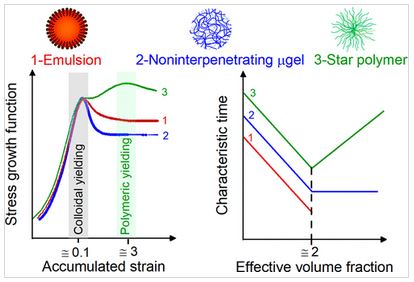Leo Gury, Mario Gauthier, Jean-Marc Suau, Dimitris Vlassopoulos, Michel Cloitre
ACS Nano, 2025, asap
http://doi.org/10.1021/acsnano.5c00464
We propose a microstructural classification of jammed suspensions made of soft, deformable colloids with purely repulsive interactions. Three distinct classes of particles are identified, depending on their ability to accommodate topological constraints upon increasing concentration : emulsions with constant particle volume, noninterpenetrating microgels (without dangling ends), which deswell osmotically, and star polymers, which deswell and interpenetrate. Each class has a specific rheological response in transient and steady-state flows. The transient behavior of emulsion-like systems and noninterpenetrating microgel suspensions is characterized by a single colloidal yielding process, whereas dispersions of star-like particles exhibit both colloidal and polymeric yielding due to their fuzzy microstructure with dangling arms. The flow of emulsions and microgels or stars at relatively low concentrations is characterized by a single process that controls cooperative rearrangements. Deswelling and interpenetration mark a departure from this universality and lead to more complex flow mechanisms. This simple generic description of yielding and flow demonstrates the importance of the microstructure and at the same time serves as a powerful indicator of the internal microstructure of particles.



